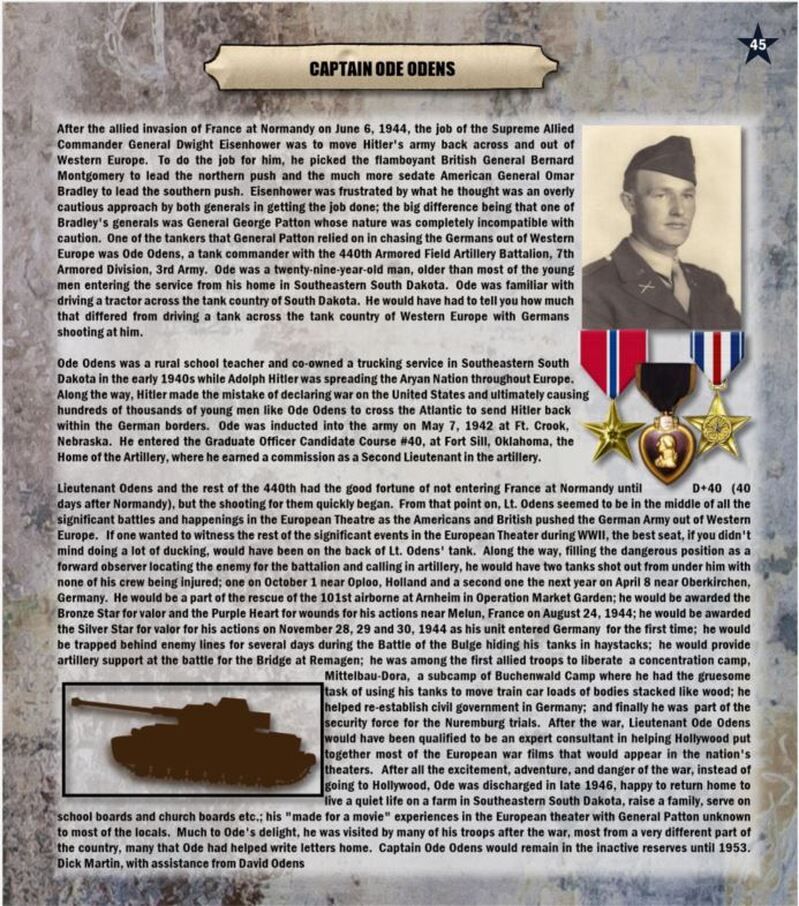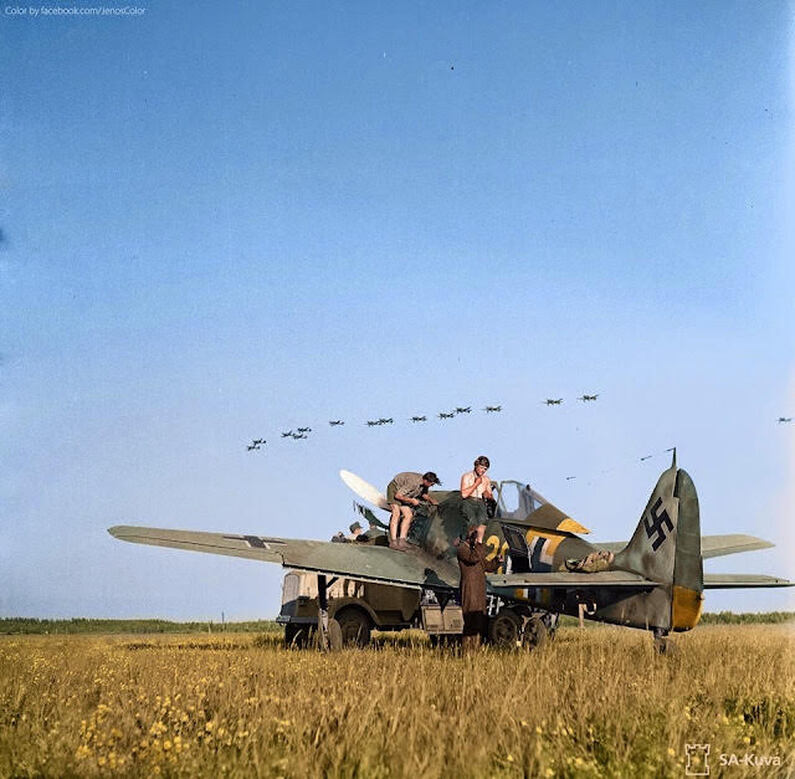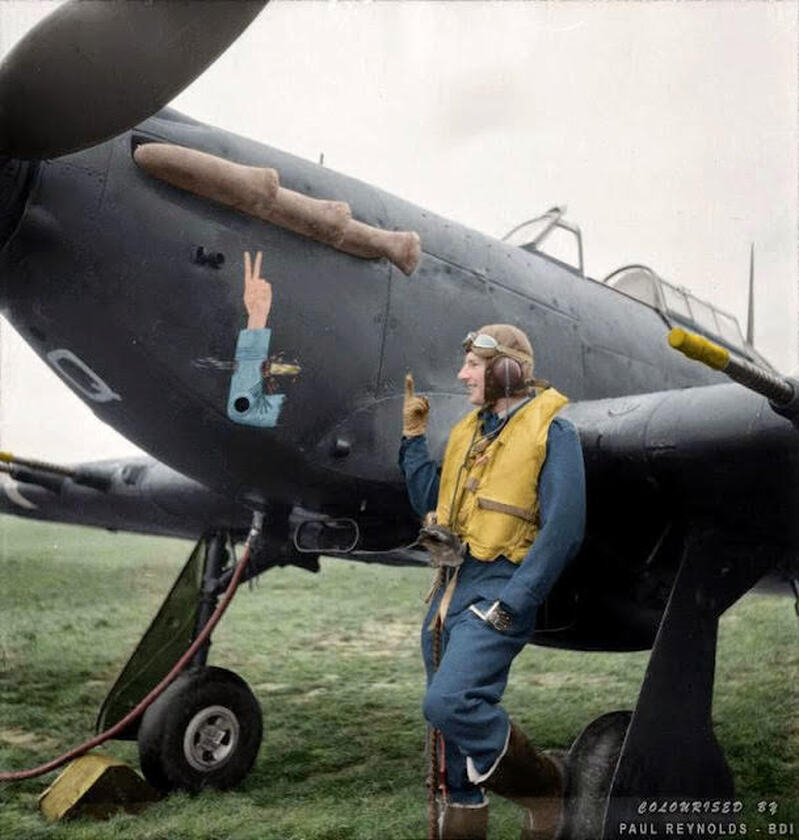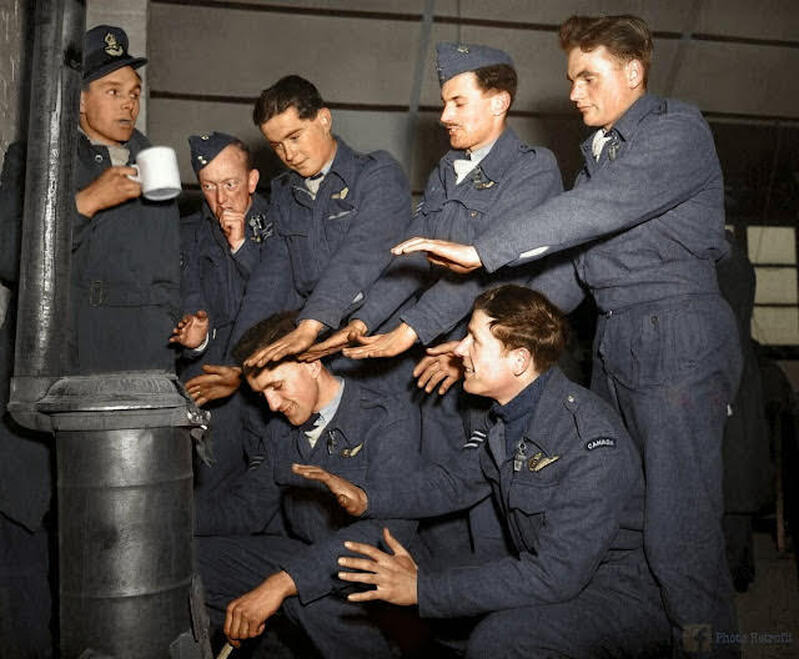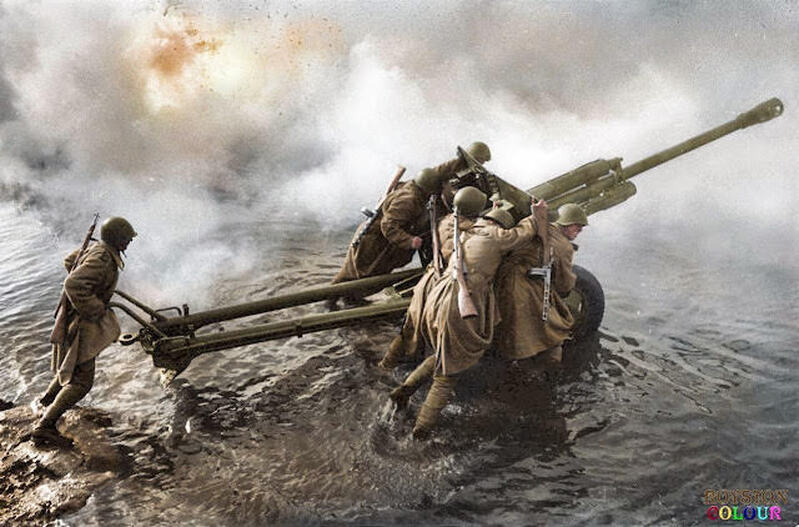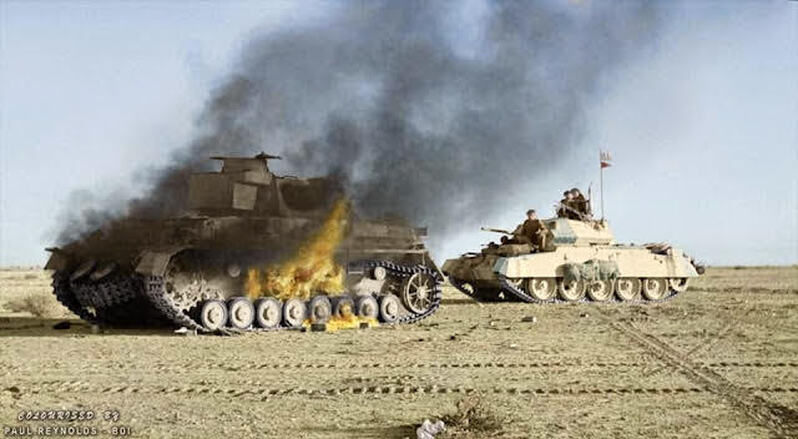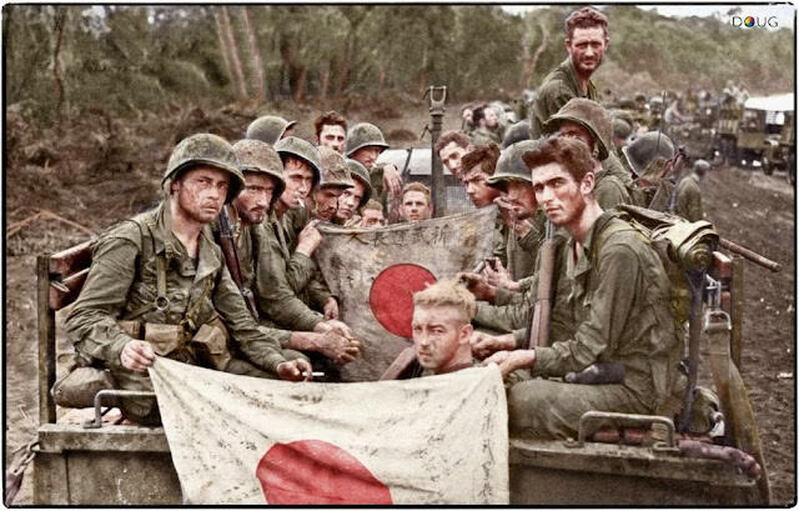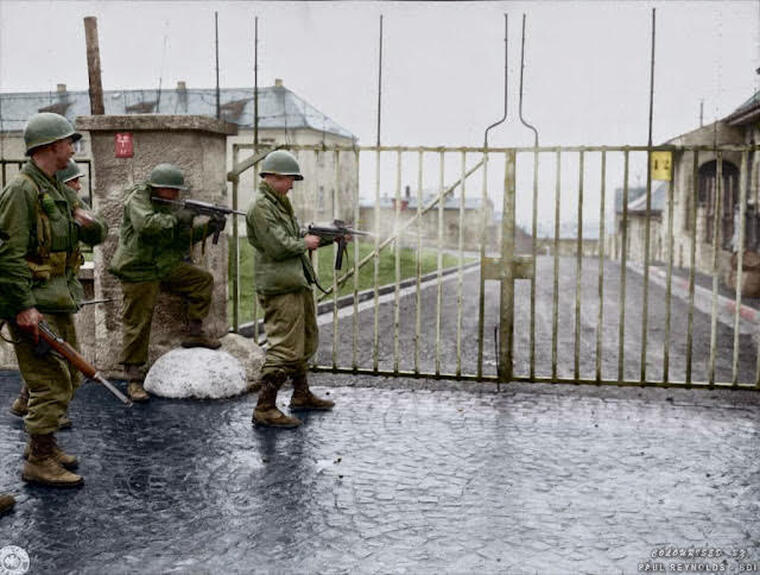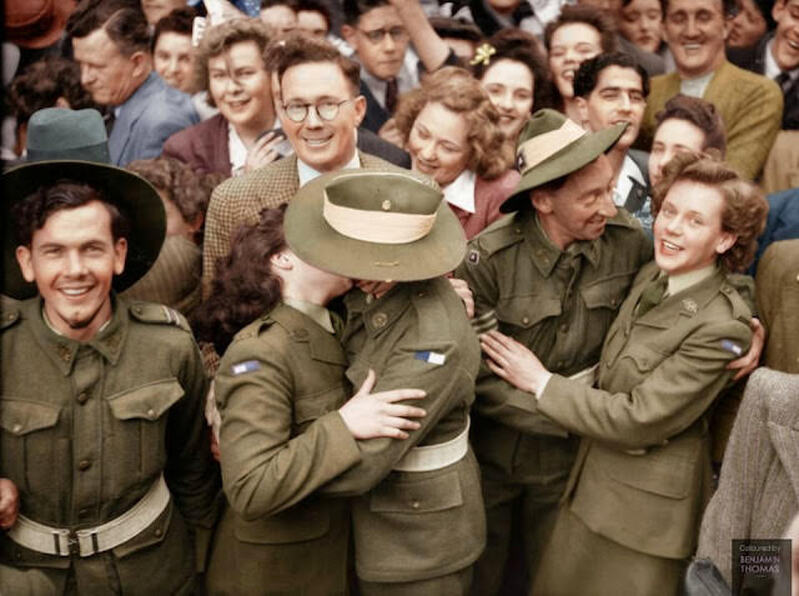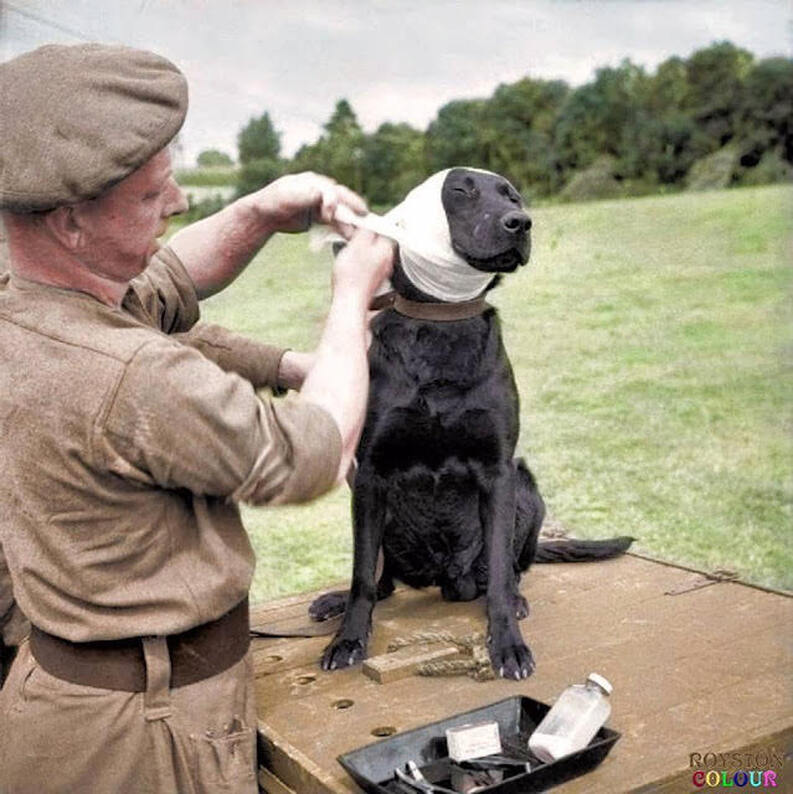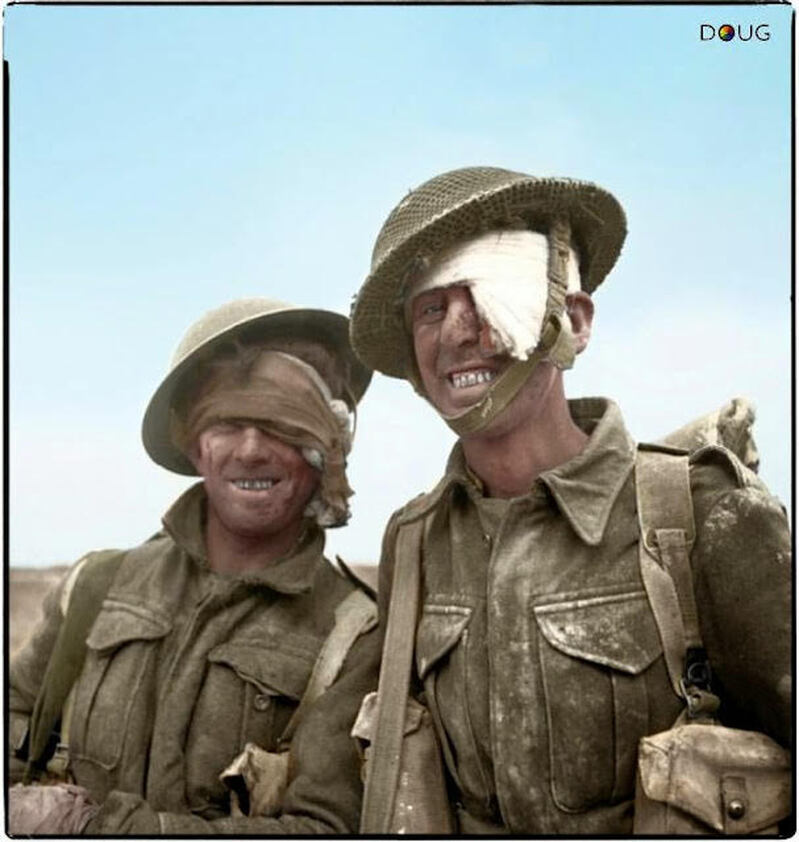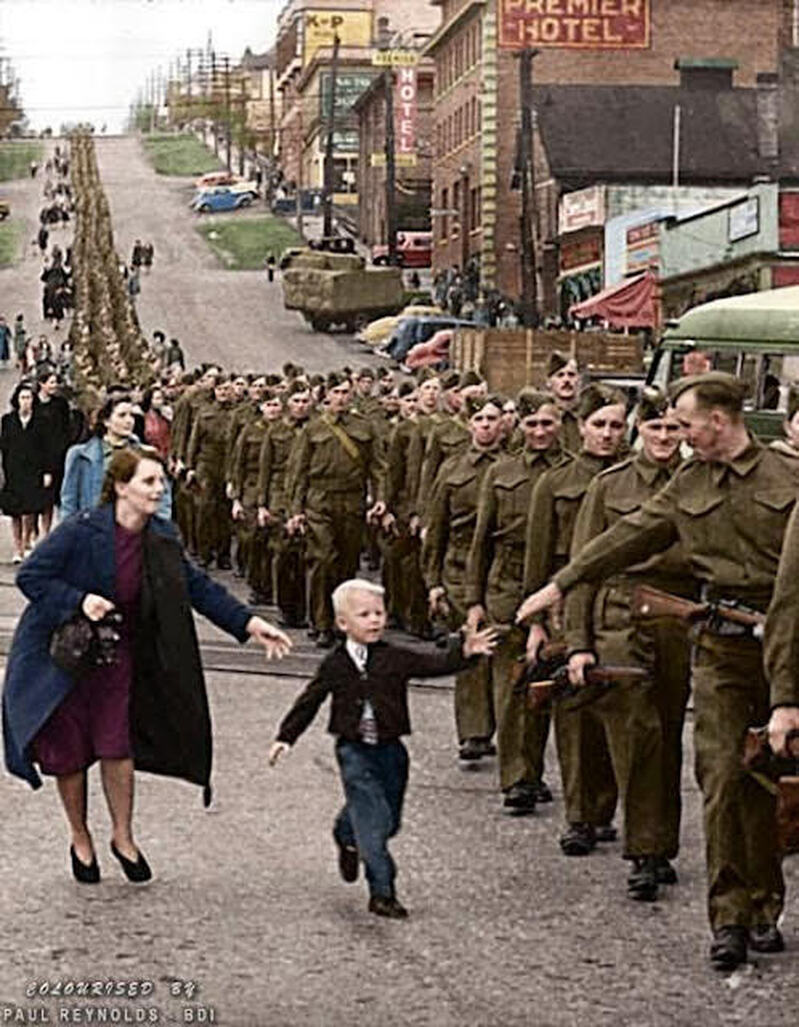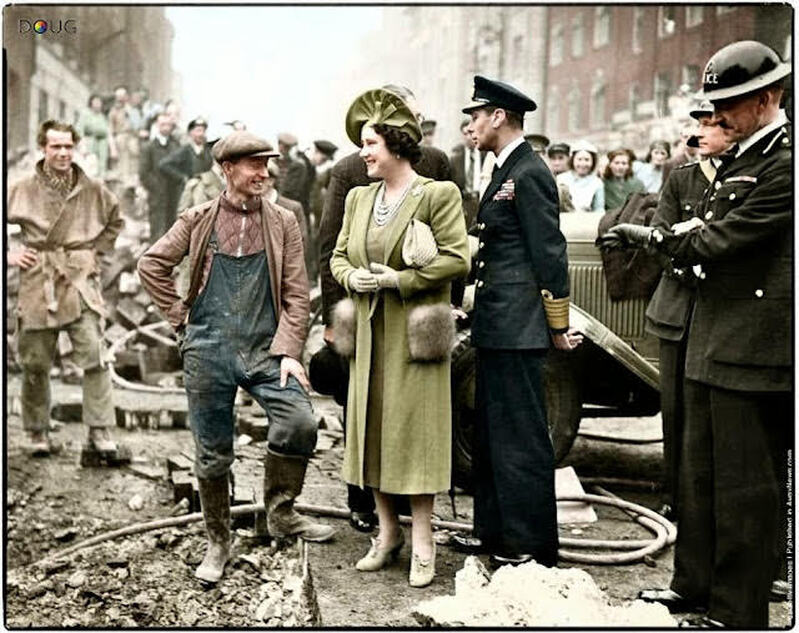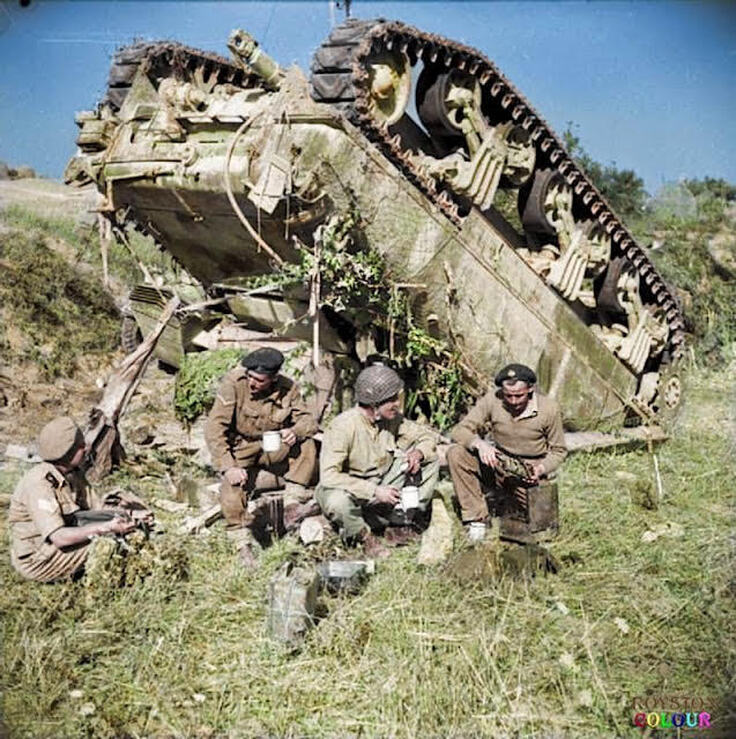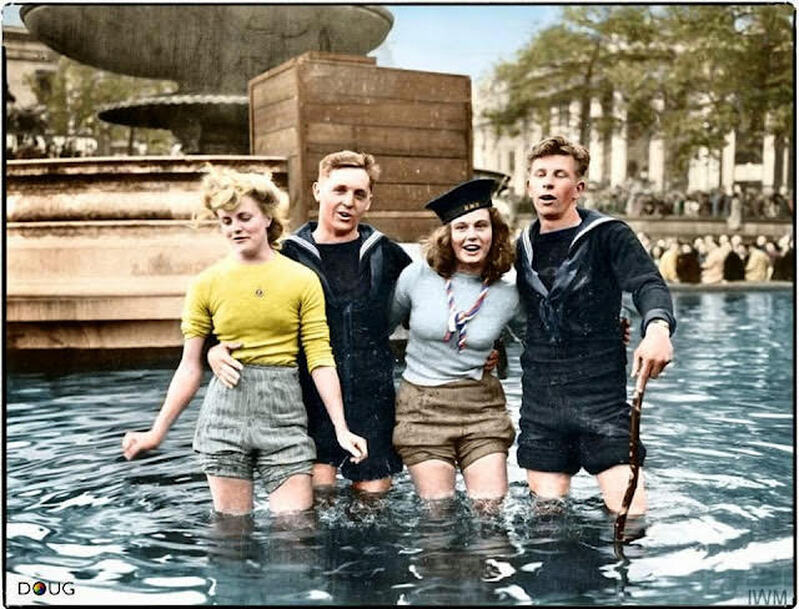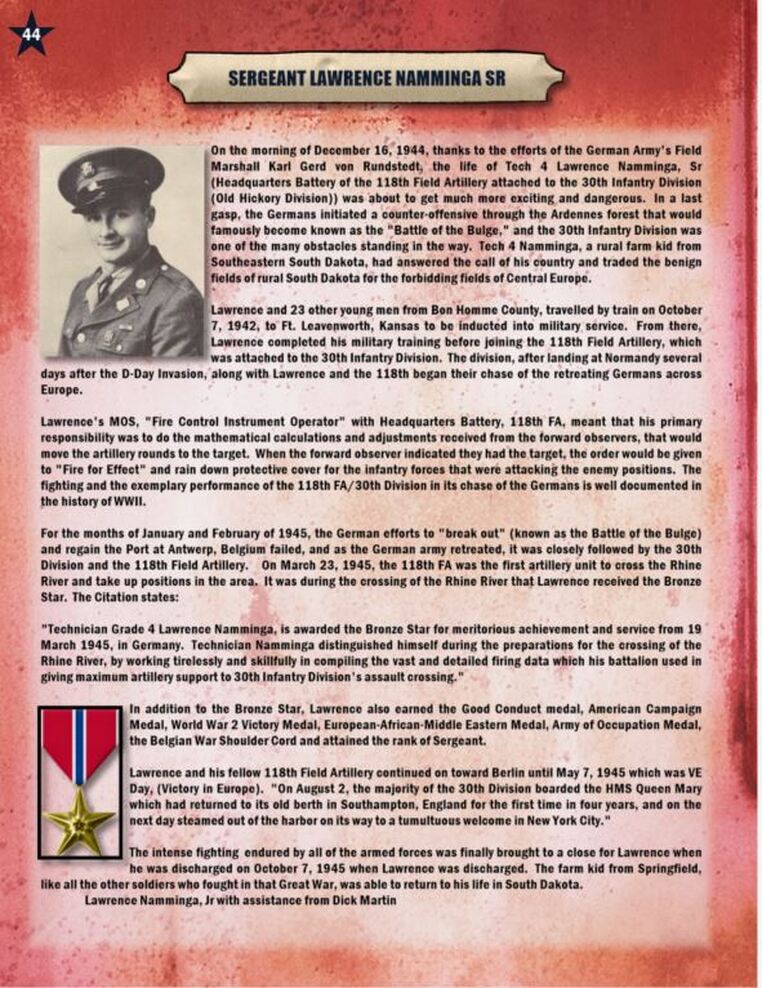|
Submitted by Carol (Lange) Wysuph A Supermarine Spitfire Vc 'Tropical' JK707 MX-P serving with 307th Fighter Squadron, 31st Fighter Group operated by 12th USAAF. The regular pilot was 1st Lt. Carroll A. Prybylo, but when lost it was flown by Capt. Virgil Cephus Fields, Jr. (Source - US Navy, via Library of Congress. Colorized by Paul Reynolds. Historic Military Photo Colourisations)  A Finnish Soldier practices maneuvers in the winter snow at a military dog training school during the Finnish-Soviet Continuation War. Hameenlinna, Finland. February 1941. (Source - SA-kuba. Colorized by Jared Enos) Focke Wulf FW-190A6 Nº20 of 4./Jagdgeschwader 54 (JG 54) on the airfield at Immola in Finland . 2nd of July 1944. (Source - SA-kuva. Colorized by Jared Enos) A Chinese Nationalist soldier guards a row of Curtiss P-40 'Warhawks' flown by the 'Flying Tigers' of the American Volunteer Group (AVG). July, 1942. (Source - National Archives and Records Administration - 535531. Colorized by Tom Thounaojam from India ) A crew member cleaning the barrel of an Sd.Kfz. 251/9 - Schützenpanzerwagen (7.5 cm KwK 37 L/24) "Stummel" on the East Front, c. Summer 1942. (Colorized by Royston Leonard from the UK ) Boeing B-29 Superfortress 42-24592 “Dauntless Dotty” 869th Bomb Squadron, 497th Bomb Group, 73rd Bomb Wing, 20th Air Force. 24th of November 1944. (Source 'Life' Magazine. Colorized by Leo Courvoisier from Argentina ) Soviet Air Force officers, Rufina Gasheva (848 night combat missions) and Nataly Meklin (980 night combat missions) decorated as 'Heroes of the Soviet Union ' for their service with the famed 'Night Witches' unit during World War II. They stand in front of their Polikarpov Po-2 biplanes. (Colourisation and research by Olga Shirnina from Russia ) A Kriegsberichter (war correspondent) holding an Arriflex 35 2 1942 camera 35mm ACR 0292 and he is leaning against a knocked out Soviet BT-5 light tank. c.1940/41. (Colorized by Royston Leonard from the UK ) Squadron Leader J.A.F. MacLachlan, the one-armed Commanding Officer of No 1 Squadron RAF, standing beside his all-black Hawker Hurricane Mark IIC night fighter, 'JX-Q', at Tangmere in West Sussex, England . (Source - Royal Air Force official photographer Woodbine G (Mr) © IWM CH 4015. Colorized by Paul Reynolds. Historic Military Photo Colourisations) US Air Force pilot 2nd Lieutenant Robert Wade Biesecker with his crew of the 569th Bombardment Squadron, 390th Bomb Group, US Eighth Air Force, standing by 'Honey Chile', their B-17 Flying Fortress bomber (serial 42-31027), at RAF Framlingham, a US Eighth Air Force Bomber Command station in England, 18 October 1943. (Photographer: M. McNeil, for Fox Photos. Images courtesy of the Hulton Archive/ Getty Images. Colorized and researched by Benjamin Thomas from Australia ) F/L J. F. Thomas and the crew of Avro Lancaster Bomber 'B' MkI 'Victorious Virgin' RF128 QB-V of RCAF 424 Squadron "Tiger" Squadron on the 21st of March 1945. (probably taken at the Skipton-on-Swale, North Yorkshire airfield). (Colorized by Tom Thounaojam from India ) T/5 William E. Thomas and Pfc. Joseph Jackson prepare a gift of special “Easter Eggs” for Adolf Hitler and the German Army. Scrawling such messages on artillery shells in World War II was one way in which artillery soldiers could humorously express their dislike of the enemy. Easter Saturday, March the 10th 1945, during the Battle of Remagen. (The photographer 1st Lt. John D. Moore of the Signal Corps. Source - US National Archives 111-SC-202330. Colorized by Johhny Sirlande from Belgium ) A paratrooper from the American 17th Airborne Division gets a light from a Churchill tank crewman of 6th Guards Armoured Brigade near Dorsten in North Rhine-Westphalia, Germany , 29th of March 1945. (Source - No 5 Army Film & Photographic Unit - © IWM BU 2738. Photographer - Sgt.Midgley. Colorized by Paul Reynolds. Historic Military Photo Colourisations) A broken down and deserted Soviet T-35 heavy tank of the 8th Mechanised Corps. On the Dubno - Plycza highway, Rivne Oblast (province) of western Ukraine . June/July 1941. (Colorized by Royston Leonard from the UK ) Troops of the 17th U.S. Airborne Division, First Allied Airborne Army, march past a blazing building in Appelhülsen , Germany , as they advance toward the city of Münster , nine miles to the northeast. First Allied Airborne Army troops had landed east of the Rhine river on March 24th 1945. (Colorized by Doug) Flying Officer Leonard Haines of No. 19 Squadron RAF sits by the cockpit of his Supermarine Spitfire Mk.Ia (QV-?) at Fowlmere, near Duxford. September 1940. (Photo Source - © IWM CH 1373. Colorized by Paul Reynolds. Historic Military Photo Colourisations) 'Dog Beach Patrol', (possibly on Parramore Beach , Virginia , US . October 1943). (Source - United States Coast Guard - Photo No.726. Colorized by Royston Leonard from the UK ) An Allied Soldier takes a break during the approach to Tripoli , Libya beside a swastika and the words 'Heil Hitler' that have been carved into a rocky hillside during January 1943. (Source - © IWM E 21788. Colorized by Royston Leonard from the UK ) The crew of Avro Lancaster "C for Charlie" of No. 44 ( Rhodesia ) Squadron RAF, try to warm themselves in their Nissen hut quarters at Dunholme Lodge, Lincolnshire , England , after returning from a raid on Stuttgart , 2nd of March 1944. (Source - © IWM (CH 12379. Colorized by Paul Edwards) United States Marines climbing down the nets into landing craft during the Battle of Peleliu, September-November 1944. (Photographer: Griffin Image courtesy of the United States Marine Corps History Division, Peleliu 117058. Colorized and researched by Benjamin Thomas from Australia ) Girls working on shell caps in a munitions factory, somewhere in England . 25th of May 1940. (Source - Gettys Images - Photographer, Paul Popper. Colorized by John Gulizia from America ) Medics of the US . 5th Infantry Division examining GI clothing found with German-captured equipment after the liberation of the area, near Diekirch in Luxembourg on the 20th of January 1945. (Source - SC-327129 Signal Corps Photo ETO-HQ-45-9223 -Horton. Colorized by Joe y Van Meesen from the Netherlands ) A Finnish Brewster Buffalo 239 fighter (BW-352) of (Squadron) Lentolaivue/24 at Selänpää airfield. 24th June 1941. (Source - SA-Kuva. Colorized by Tommi Rossi from Finland ) Three troopers of the 507th Parachute Infantry Regiment, 17th Airborne Division taking a break after 5 days frontline fighting. From left to right : Pvt William H. Sandy (ASN 13032007) from Charlottesville, VA, Sgt Dehaven Nowlin (ASN 15046241) from Goshen, KY and Pvt Howard Fredericks (ASN 39241668) from Los Angeles, CA., near Essen (Germany) 10th of April 1945. (Source - US Army Signal Corps - TFH collection. Photographer - Sgt T. J. Austin (Signal Corps). Colorized by Joshua Barrett from the UK ) Veronica Foster, (b.1922 - d.2000) popularly known as "Ronnie, the Bren Gun Girl", was a Canadian icon representing nearly one million Canadian women who worked in the manufacturing plants that produced munitions and materiel during World War II. Colorized by Paul Reynolds. Historic Military Photo Colourisations) An American Marine aiming his Garand M1 rifle, whilst perched on Japanese ammunition crates on the Island of Iwo Jima , c. February/March 1945. (Colourised by Royston Leonard from the UK ) Royal Marines from 45 (RM) Commando, 1st Commando Brigade on the look-out for snipers among the ruins in Osnabrück, Lower Saxony, Germany. 4th of April 1945. (Source - IWM BU 3057. Photographer - Sgt.Laws No 5 Army Film & Photographic Unit. Colorized by Doug) Soviet artillerymen transporting a 76-mm divisional gun M1942 (ZiS-3) during the forced crossing of the Oder River, Germany, c. December, 1944. (Photograph by Dmitri Baltermants. Colorized by Royston Leonard from the UK ) Marine Pfc. Douglas Lightheart (right) cradles his .30 caliber M1919 Browning machine gun in his lap, while he and Marine Pfc. Gerald Thursby Sr. take a cigarette break, during mopping up operations on Peleliu on 14th September 1944. (Colorized by Paul Reynolds. Historic Military Photo Colourisations) A British Crusader tank passes a burning German Panzer IV tank during 'Operation Crusader'. Cyrenaica (the eastern province of Libya ). Winter 1941. (Colorized by Paul Reynolds. Historic Military Photo Colourisations) The strain and fatigue of 23 days on the line is shown by Marines of Combat Team 'C', 2/7th US Marines, 1st Marine Division seen here displaying Japanese battle flags captured during the Battle of Cape Gloucester. 14-15th January 1944. (Source USMC 71602. Colorized by Doug) "Lucky Strike" c. 1944. The United States was the only country to equip its troops with an auto-loading rifle as the standard infantry weapon of WWII. It gave their troops a tremendous advantage in firepower, and led General George Patton to call the M1 Garand, “The greatest battle implement ever devised.” (Colorized by Paul Reynolds. Historic Military Photo Colourisations) Crew members of Nº537 Soviet IS-2 tank of the 87th Guards Heavy Tank Regiment take a break in Breslau (now Wrocław in Poland ) 27th April 1945. (Photographer - Anatoli Egorov. Colorized by Jiří Macháček from the Czech republic ) US troops from Combat Command B of the U.S. 14th Armored Division entering the Hammelburg Prison in Germany by opening the main gate with bursts of their M3 "Grease Guns". Hammelburg , Germany . April 6, 1945. (Colorized by Paul Reynolds. Historic Military Photo Colourisations) A US Marine wearing his camouflage suit fires a Thompson sub-machine gun during Jungle Training - 1942. (Colorized by Paul Reynolds. Historic Military Photo Colourisations) Australian soldiers mingle with a section of the crowd gathered in Martin Place during the Victory in the Pacific celebrations, Sydney , 15 August 1945. (Colorized and researched by Benjamin Thomas from Australia ) British Prisoners of War celebrate their liberation from Stalag X1B, 16th April 1945. (Colorized by Paul Reynolds. Historic Military Photo Colourisations) Two German members of the Organisation Todt (involved in the construction of the Atlantic Wall) are sitting on the Spitfire brought down on the wet sands at Calais by Flying Officer Peter Cazenove. It had been hit by a single bullet from a German Dornier bomber. The plane was consumed by the sandy beach and remained there for 40 years. (Colorized by Paul Reynolds. Historic Military Photo Colourisations) A Sergeant of the Royal Army Veterinary Corps bandages the wounded ear of a mine-detection Labrador dog named 'Jasper' at Bayeux in Normandy , 5th of July 1944. (Source © IWM B 6496 - Sgt. Christie , No 5 Army Film & Photographic Unit. Colorized by Royston Leonard UK ) Two wounded soldiers from the 6th Durham Light Infantry, 50th (Northumbrian) Infantry Division, XXX Corps., during the Mareth line battle, 22-24 March 1943. (Colorized by Doug) A Browning Automatic Rifle (BAR) man in the bow of the rubber landing craft provides covering fire as a 10-man boat crew of the US Marine 3rd Raider Battalion reaches the undefended beach of Pavuvu in the Russell Islands during 'Operation Cleanslate'. February 1943. (Source - USMC ID #: 54765. Colorized by Royston Leonard UK ) From Left to Right, B-25 crew members: Sgt. John C. Bellendir (Gnr.), Chicago; Sgt. Raymond J. Swingholm (Eng/Gnr.), Lebanon, PA; Sgt. Harris B. Pate (Rd/Gnr.), Hamlet, NC; Red Cross Clubmobile Worker, Peggy Steers from White Plains, NY. and T/Sgt. Aubrey Chatters (Rd/Gnr.), Milington MI. All from the 321st Bombardment Group, 447th Bombardment Squadron,12th Air Force. Alesani Airfield, Corsica , 2nd of July 1944. (Photographer - Ollie Atkins, reporter for the American Red Cross. Colorized by Lori Lang from America ) On October 1, 1940, Private Jack Bernard and other volunteers in The British Columbia Regiment (Duke of Connaught’s Own Rifles) were marching smartly down Eighth Street in New Westminster to board a ship and sail off to war. Suddenly, Bernard’s five-year-old son broke free of his mother’s grasp and sprinted into the military formation to take his smiling father’s hand. In that instant, an alert Vancouver Daily Province photographer, Claude Dettloff, snapped the shutter. Soon, his unforgettable image of little Warren “Whitey” Bernard was being printed by leading publications throughout North America . It was later used in Canada ’s war bond drives with the plea, “help bring my Daddy home.” Jack Bernard survived the war and was reunited with his son in 1945. (Claude Dettloff, photographer - City of Vancouver Archives online database. Colorized by Paul Reynolds. Historic Military Photo Colourisations) King George VI and Queen Elizabeth visiting bomb damaged streets in the East End of London on the 18th of October 1940. (Colorized by Doug) While his father chats with a customer at the hardware store, a uniformed Jimmy Stewart sets up a date to go fishing,1945. (Colorized by John Gulizia from America ) The crew of an up-ended (M4A1) Sherman tank of the 7th Armoured Brigade enjoy a ‘brew’ beside their vehicle while waiting for a recovery team, on the 'Gothic Line' in Italy , 13th of September 1944. Their tank overturned after slipping off a narrow road in the dark. (Source - IWM NA 18551 - Dawson (Sgt), No 2 Army Film & Photographic Unit. Colourised by Royston Leonard UK ) At 2.41am on the morning of 7 May 1945, at Allied headquarters in Reims , France , Chief-of-Staff of the German Armed Forces High Command, General Alfred Jodl, signed the unconditional surrender of all German forces to the Allies. The West awoke to the news the following day, with celebrations being held around the world for the Victory in Europe - VE Day, 8 May. (Colorized and researched by Benjamin Thomas from Australia ) Margaret Sevilla, Los Angeles . May 7, 1945. VE Day! (Colorized by Patty Allison from America ) Two British sailors celebrate VE Day with their girlfriends in the fountains at Trafalgar Square . London , England . Tuesday the 8th of May 1945. (Source - © IWM EA 65799. United States Army Signal Corps photographer T G Massecar. Colorized by Doug) 9th Army MPs reading of the surrender in the 'Stars and Stripes' in Germany on the 8th of May 1945. (Source - U. S. Army Military History Institute - Nelson A. Shuey Photograph Collection. Colorized by Royston Leonard UK ) Co-pilot- G. Boyd Jr.
Navigator- Harry C. Nuessle Bombardier- Ralph Burbridge Engineer- Joe C. James RadioOperator-Paul A. Galloway Ball Turret Gunner- Elton Conda Waist Gunner- Michael Zuk Tail Gunner- Sam T. Sarpolus Ground Crew Chief- Hank Hyland In 1943 a mid-air collision on February 1, 1943, between a B-17 and a German fighter over the Tunis dock area, this became the subject of one of the most famous photographs of WW II. An enemy fighter attacking a 97th Bomb Group formation went out of control, probably with a wounded pilot, then continued its crashing descent into the rear of the fuselage of a Flying Fortress named "All American", piloted by Lt. Kendrick R. Bragg of the 414th Bomb Squadron. When it struck, the fighter broke apart, but left some pieces in the B-17. The left horizontal stabilizer of the Fortress and left elevator were completely torn away. The two right engines were out and one on the left had a serious oil pump leak. The vertical fin and the rudder had been damaged. The fuselage had been cut almost completely through connected only at two small parts of the frame and the radios, electrical and oxygen systems were damaged. There was also a hole in the top that was over 16-feet long and 4 feet wide at its widest. The split in the fuselage went all the way to the top gunner's turret. |
Categories
All
Archives
October 2023
|
